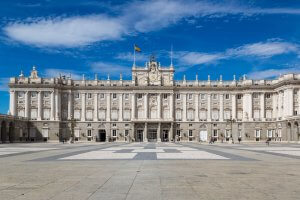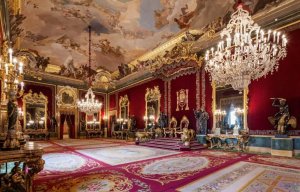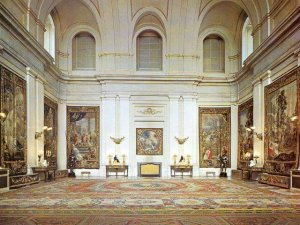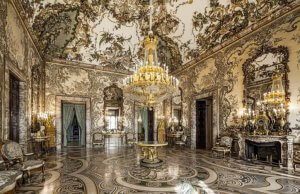Take A Look Inside The Royal Palace of Madrid

Madrid is a must-see city for any tourists visiting Spain. Its rich heritage makes it a top destination for people from all over the world. With this in mind, we want to take a closer look at some of the main rooms inside the Royal Palace of Madrid.
Anyone visiting the city will want to tick off some of the most famous buildings, landmarks and monuments it has to offer: the Plaza Mayor, Gran Vía, The Prado Museum, The Queen Sofia Museum, Almudena Cathedral, Retiro Park, and a whole host of churches from all different eras. In short, Madrid boasts a huge range of cultural landmarks.
One of the most notable historical sites is the Royal Palace of Madrid. It’s a building steeped in history and a key example of Baroque architecture in the world of interior design. It also has a huge collection of artwork and furniture of great cultural significance.
The Royal Palace of Madrid – history

It was King Felipe V who commissioned the Palace’s construction. He decided that the old fortress was no longer befitting of the royal family’s status within Europe. When it burned down in 1734, it left the site free for the construction of the new palace.
The first monarch to reside in the palace was Charles III. It was used as the royal residence right up to the time of Alfonso XIII when it became a reflection of the Enlightenment era that came about in the second half of the 18th Century. The ornate decor was also a symbol of the grandeur of the Spanish court.
In this post, we’ll take a closer look at some of the Royal Palace’s most important rooms: the Throne Room, the Hall of Halberdier’s, and the Gasparini Room. They contain some of the best examples of the Palace’s stunning artwork, as well as several unique architectural, sculptural, and decorative features.
Discovering the past helps us to better understand the present.
The Throne Room: unparalleled elegance

As the name suggests, this is where the main throne of the Spanish court is located. The grandeur, opulence, and glamour create a look that reflected the importance of the royal family. But what are the main features of this room?
- The main color here is a deep garnet, reflecting a sense of charm and finesse. The velvet hangings on the walls also feature silver details to further enhance this aesthetic.
- The floor is carpeted with a set of garnet red rugs, which decorated with classic rococo prints. Following the 18th Century French Versailles style, the designer has sought to decorate every inch of the room.
- Mirrors are also a key part of this space, along with the central ceiling lamp. Only the most costly materials have been used, with plenty of gold and silver details. Every last inch of the Throne Room is richly decorated.
- The furniture, including the dual thrones and the four lions flanking them on either side, is covered with a gold finish and made using the carving techniques typical of the late Baroque period. The gold color is a clear symbol of royal elegance.
- Look up, and you’ll find Tiepolo’s famous ceiling fresco. Painted using the trompe-l’oeil technique, it has a deceptive effect on the eyes.
The Royal Palace of Madrid – The Halberdier’s Room

In this room, the designer has gone in a slightly different direction. The architectural features are visible, showing off pillars and architraves in all their splendor.
As the white, block-ish walls themselves bear hardly any decoration, they have been brought to life with many paintings by Giambattista Tiepolo. The upper section of the walls features lunettes and windows to allow in plenty of light.
Once again, the floor is covered with a large carpet featuring an intricate rococo print. Red tones become less prominent here, giving way to a range of other shades. The polychromy of the carpet helps brighten the relatively simple decor.
The Gasparini Room and the concept of horror vacui

The first thing you notice upon entering this room is how narrow it is. In comparison with the other rooms, this space is much smaller, giving it a more intimate feel.
The decoration is sumptuous and ornate. In what is known as horror vacui (fear of emptiness), every inch of the room is richly decorated. From floor to ceiling, this aesthetic is instantly recognizable as rococo, with elegant gilding and Baroque-style designs.
Madrid is a must-see city for any tourists visiting Spain. Its rich heritage makes it a top destination for people from all over the world. With this in mind, we want to take a closer look at some of the main rooms inside the Royal Palace of Madrid.
Anyone visiting the city will want to tick off some of the most famous buildings, landmarks and monuments it has to offer: the Plaza Mayor, Gran Vía, The Prado Museum, The Queen Sofia Museum, Almudena Cathedral, Retiro Park, and a whole host of churches from all different eras. In short, Madrid boasts a huge range of cultural landmarks.
One of the most notable historical sites is the Royal Palace of Madrid. It’s a building steeped in history and a key example of Baroque architecture in the world of interior design. It also has a huge collection of artwork and furniture of great cultural significance.
The Royal Palace of Madrid – history

It was King Felipe V who commissioned the Palace’s construction. He decided that the old fortress was no longer befitting of the royal family’s status within Europe. When it burned down in 1734, it left the site free for the construction of the new palace.
The first monarch to reside in the palace was Charles III. It was used as the royal residence right up to the time of Alfonso XIII when it became a reflection of the Enlightenment era that came about in the second half of the 18th Century. The ornate decor was also a symbol of the grandeur of the Spanish court.
In this post, we’ll take a closer look at some of the Royal Palace’s most important rooms: the Throne Room, the Hall of Halberdier’s, and the Gasparini Room. They contain some of the best examples of the Palace’s stunning artwork, as well as several unique architectural, sculptural, and decorative features.
Discovering the past helps us to better understand the present.
The Throne Room: unparalleled elegance

As the name suggests, this is where the main throne of the Spanish court is located. The grandeur, opulence, and glamour create a look that reflected the importance of the royal family. But what are the main features of this room?
- The main color here is a deep garnet, reflecting a sense of charm and finesse. The velvet hangings on the walls also feature silver details to further enhance this aesthetic.
- The floor is carpeted with a set of garnet red rugs, which decorated with classic rococo prints. Following the 18th Century French Versailles style, the designer has sought to decorate every inch of the room.
- Mirrors are also a key part of this space, along with the central ceiling lamp. Only the most costly materials have been used, with plenty of gold and silver details. Every last inch of the Throne Room is richly decorated.
- The furniture, including the dual thrones and the four lions flanking them on either side, is covered with a gold finish and made using the carving techniques typical of the late Baroque period. The gold color is a clear symbol of royal elegance.
- Look up, and you’ll find Tiepolo’s famous ceiling fresco. Painted using the trompe-l’oeil technique, it has a deceptive effect on the eyes.
The Royal Palace of Madrid – The Halberdier’s Room

In this room, the designer has gone in a slightly different direction. The architectural features are visible, showing off pillars and architraves in all their splendor.
As the white, block-ish walls themselves bear hardly any decoration, they have been brought to life with many paintings by Giambattista Tiepolo. The upper section of the walls features lunettes and windows to allow in plenty of light.
Once again, the floor is covered with a large carpet featuring an intricate rococo print. Red tones become less prominent here, giving way to a range of other shades. The polychromy of the carpet helps brighten the relatively simple decor.
The Gasparini Room and the concept of horror vacui

The first thing you notice upon entering this room is how narrow it is. In comparison with the other rooms, this space is much smaller, giving it a more intimate feel.
The decoration is sumptuous and ornate. In what is known as horror vacui (fear of emptiness), every inch of the room is richly decorated. From floor to ceiling, this aesthetic is instantly recognizable as rococo, with elegant gilding and Baroque-style designs.
All cited sources were thoroughly reviewed by our team to ensure their quality, reliability, currency, and validity. The bibliography of this article was considered reliable and of academic or scientific accuracy.
- AA. VV.: Palacio Real de Madrid, Madrid, Patrimonio Nacional, 1985.







